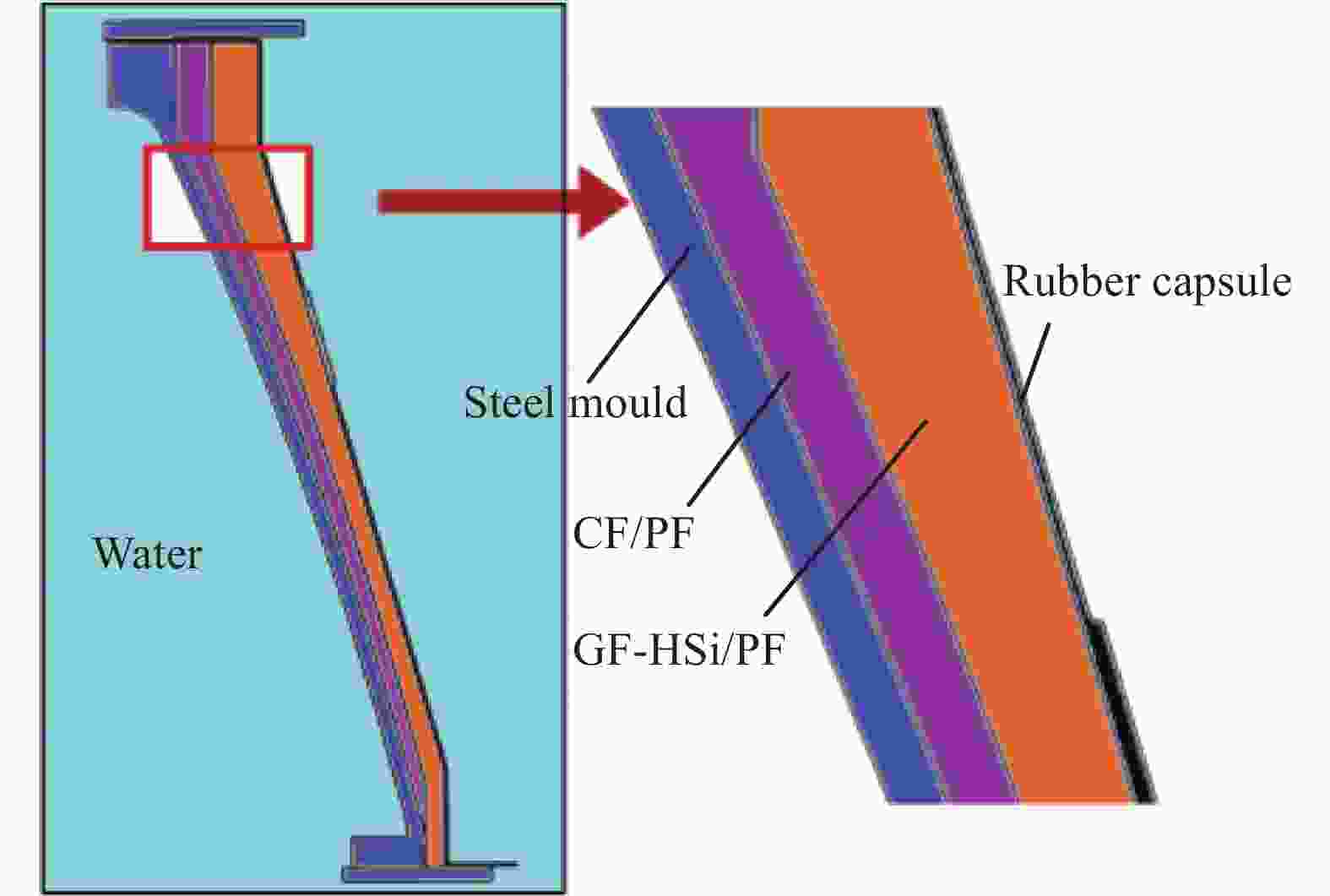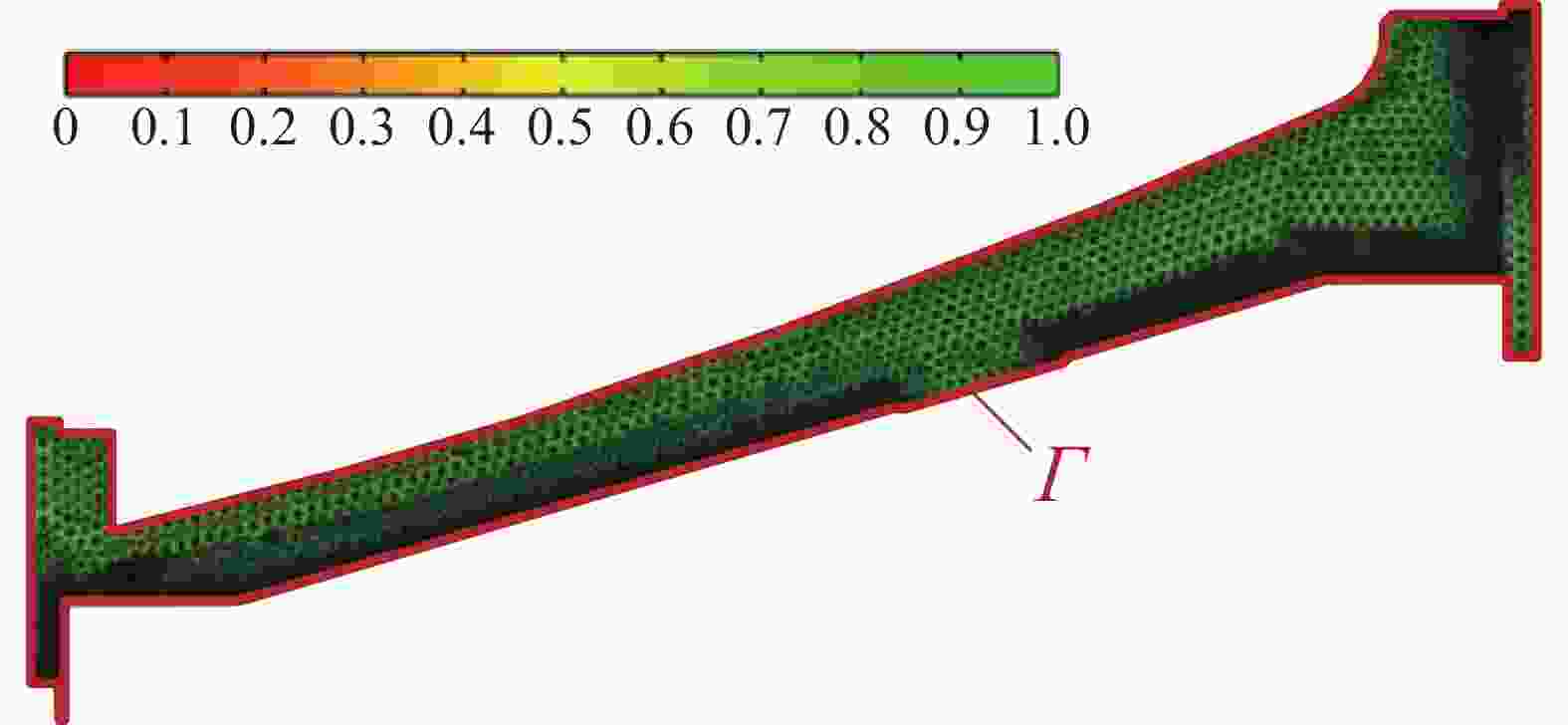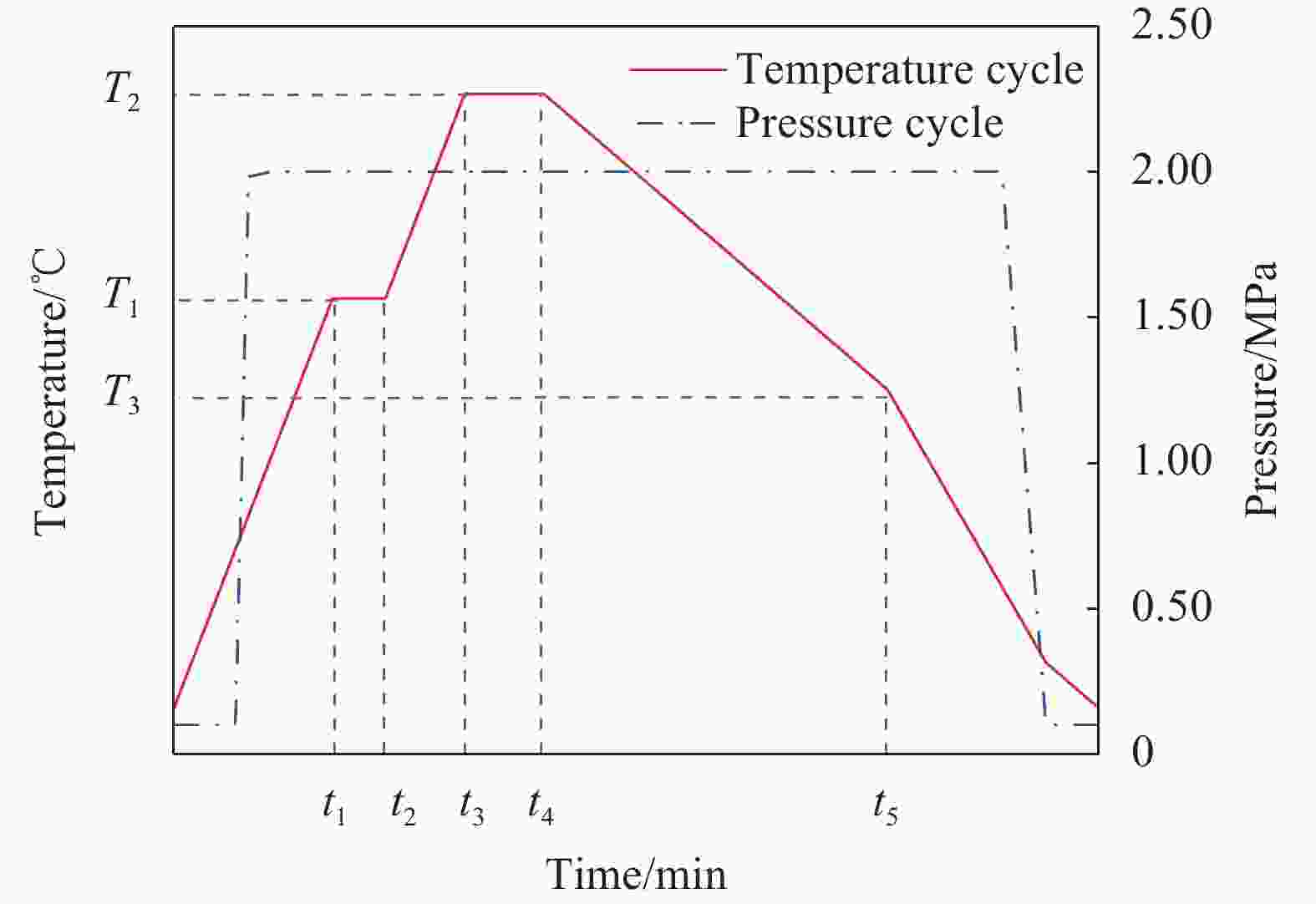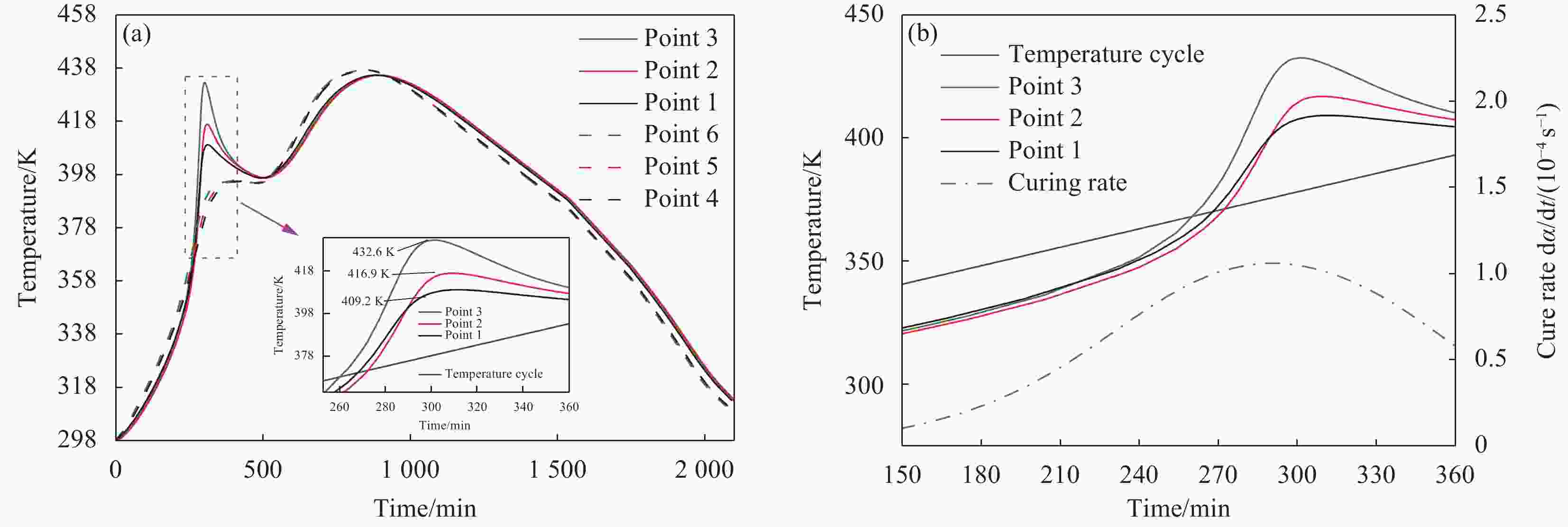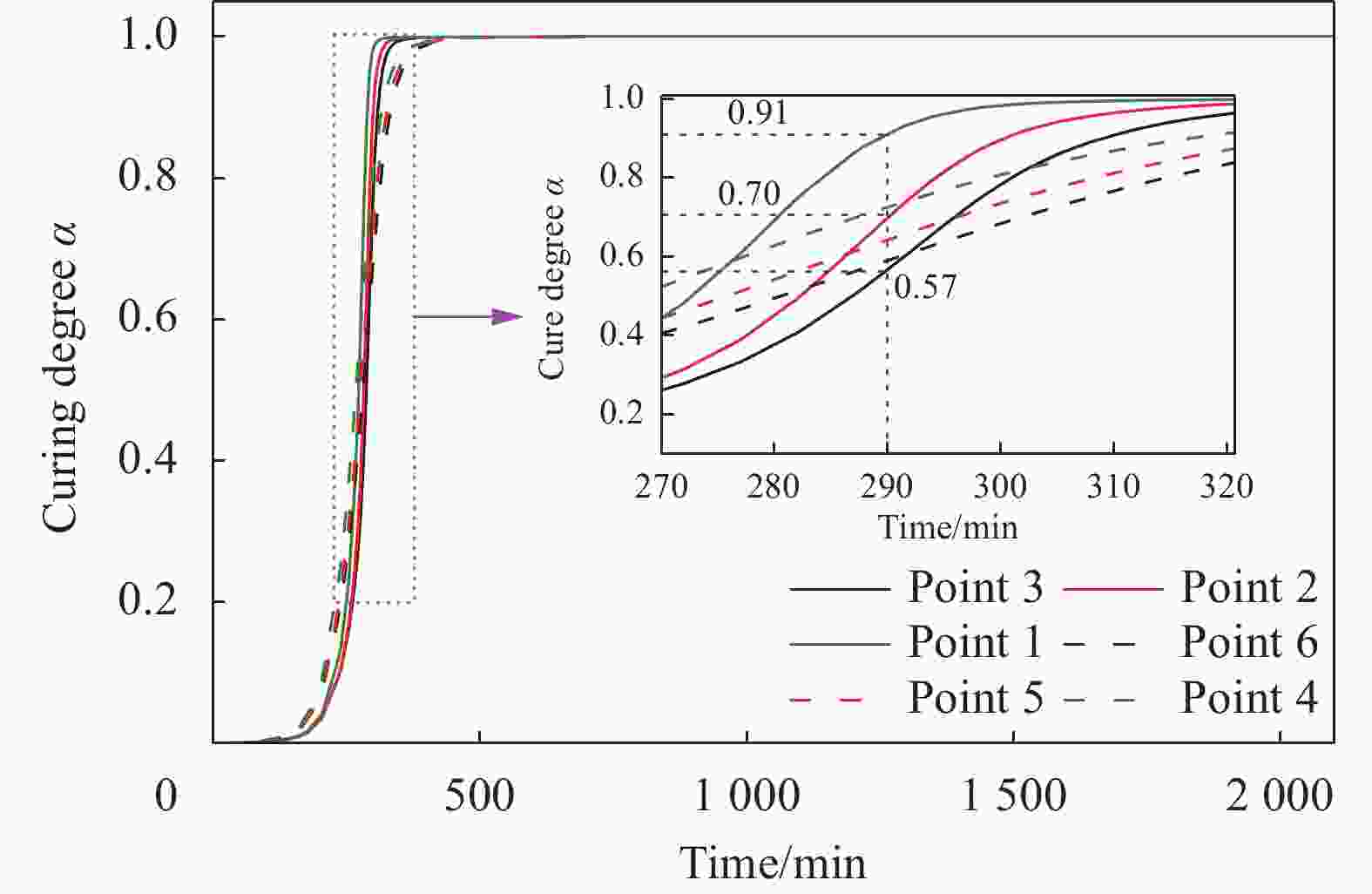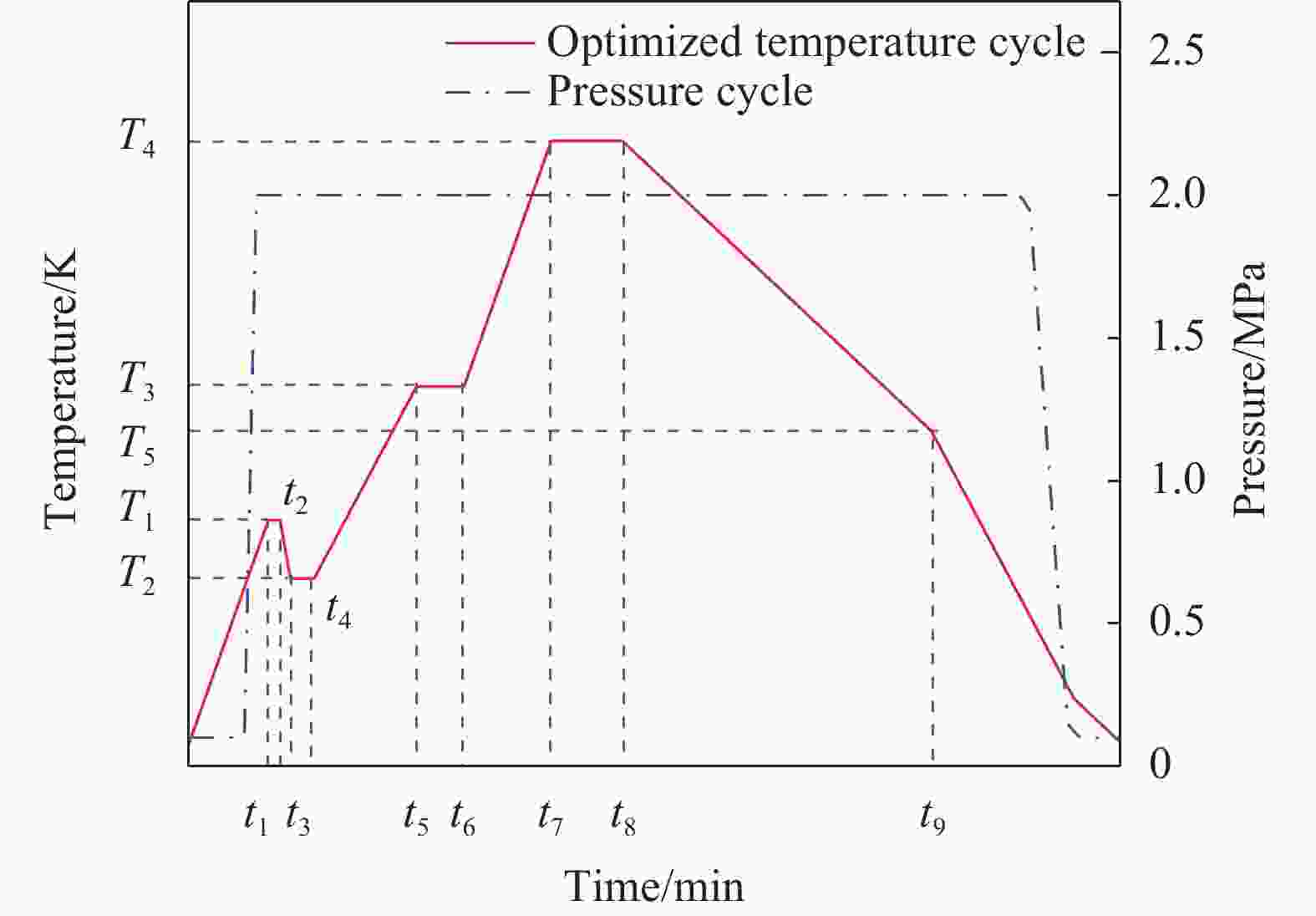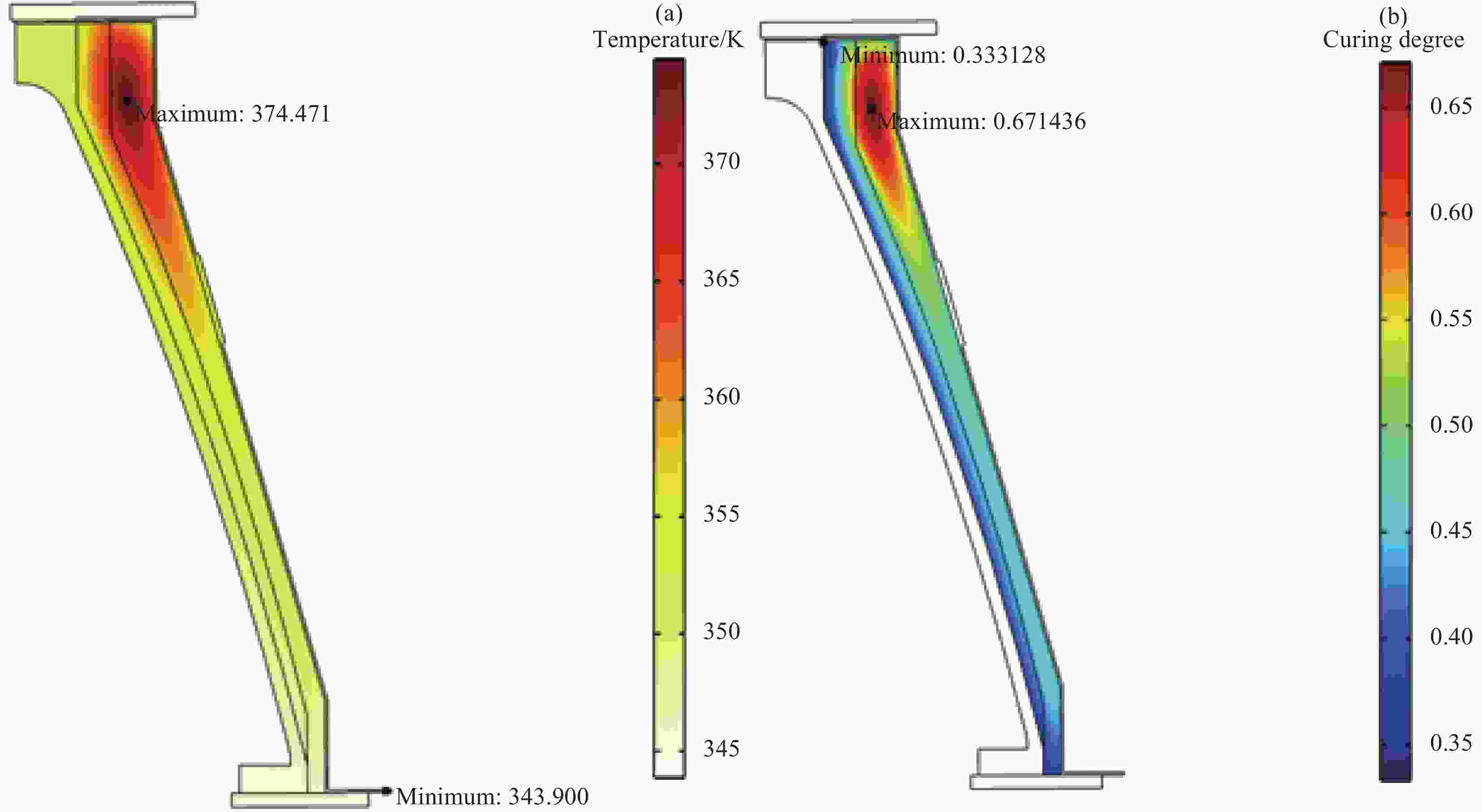Mechanical-thermal coupling analysis of curing process of composite divergent section with ultra-thick and variable curvature
-
摘要: 复合材料扩张段是固体发动机喷管的关键部件,为抵抗高温、高压、烧蚀、高速燃气和力学载荷的综合作用,其结构为超厚壁变曲率的复杂混合复合材料结构。由于扩张段的低导热性、超厚壁特征和固化工艺的不合理,成型过程容易出现剧烈的过热峰。为减小固化变形,提高扩张段成型质量,必须抑制固化过热,提高固化均匀性。本文首先采用高压差示扫描量热仪表征2 MPa压力下高硅氧玻璃纤维/酚醛和碳纤维/酚醛预浸料的动力学。然后考虑成型过程多场耦合特点及成型模具和固化工艺的影响,构建固化过程耦合模型,分析扩张段固化过热和非均匀固化现象。最后,提出在剧烈固化前插入降温段的方法优化固化工艺,抑制固化过热。结果表明,优化工艺可以有效抑制扩张段过热现象,优化后最大过热峰由54.2℃下降为23.5℃,最大固化度差值由0.6下降为0.34,下降幅度分别为56.64%和43.33%。Abstract: Composite divergent section is the key component of solid rocket motor nozzle, with the composite structure of ultra-thick and variable curvature to resist the comprehensive effects of high temperature, ablation, high-speed gas and mechanical load. Due to the low thermal conductivity of the divergent section, the characteristics of ultra-thick and the unreasonable curing cycle, severe overheating peaks are easy to appear during the molding process. In order to reduce the curing deformation and improve the forming quality of the divergent section, it is necessary to restrain the curing overheating and improve the curing uniformity. Firstly, the kinetics of high silica glass fiber/phenolic and carbon fiber/phenolic prepreg at 2 MPa were characterized by high pressure differential scanning calorimetry in this study. Then, considering the characteristics of multi field coupling in the molding process and the influence of molding die and curing process, the coupling model of curing process was constructed to analyze the phenomenon of overheating and non-uniform curing of the divergent section. Finally, the method of inserting a cooling process before vigorous curing was proposed to optimize the curing cycle and restrain the curing overheating. The results show that the optimized cycle can effectively suppress the overheating of the divergent section. After optimization, the maximum overheating peak decreases from 54.2℃ to 23.5℃, and the maximum curing degree difference decreases from 0.6 to 0.34, with the decrease ranges of 56.64% and 43.33% respectively.
-
Key words:
- divergent section /
- variable curvature /
- ultra-thick composites /
- overheat /
- asynchronous curing
-
图 6 原固化工艺
Figure 6. Conventional curing cycle
T1, T2 and T3—Temperature of the first dwelling process, the second dwelling process and the end temperature of the first cooling process, respectively; t1, t2, t3, t4 and t5—Start time of the first dwelling process, the end time of the first dwelling process, the start time of the second dwelling process, the end time of the second dwelling process and the end time of the first cooling process, respectively
图 9 扩张段特征点:(a) 结构小端;(b) 结构大端
Figure 9. Characteristic points of divergent section: (a) Small end of structure; (b) Big end of structure
Point 1, 2 and 3—Center point of CF/PF composite layer, the interface point of two layers and the center point of GF-HSi/PF composite layer at the small end of divergent section, respectively; Point 4, 5 and 6—Center point of CF/PF composite layer, the interface point of two layers and the center point of GF-HSi/PF composite layer at the large end of divergent section, respectively.
图 12 扩张段优化的固化工艺
Figure 12. Optimized curing cycle of divergent section
T4—End temperature of the first cooling process; t3, t4, t5, t6, t7, t8 and t9—Start time of the inserted cooling process, the end time of the inserted cooling process, the start time of the second dwelling process, the end time of the second dwelling process, the start time of the third dwelling process, the end time of the third dwelling process and the end time of the first cooling process, respectively
表 1 峰值温度和反应总放热量
Table 1. Peak temperature and total reaction heat release
Material β/(℃·min−1) Tp/℃ $ \Delta H $/(J·g−1) $ \Delta \bar H $/(J·g−1) GF-HSi/PF 5 155.68 114.68 103.20 10 169.80 118.94 15 178.35 101.36 20 183.87 77.81 CF/PF 5 147.50 100.96 117.44 10 162.14 116.06 15 169.91 136.77 20 175.50 115.98 Notes: β—Heating rate; Tp—Peak temperature; ΔH—Total reaction heat under different heating rate; $ \Delta \bar H $—Average total reaction heat. 表 2 GF-HSi/PF预浸料固化反应动力学参数
Table 2. Cure kinetics parameters of GF-HSi/PF prepreg
β/
(℃·min−1)Stage I (0<α<0.69) Stage II (α≥0.69) A×10−5
/
(1·s−1)m n A×10−5
/
(1·s−1)n 5 39.809 0.1982 0.9357 29.762 0.7410 10 39.458 0.1760 0.8034 30.894 0.6455 15 40.360 0.1896 0.7253 32.122 0.5885 20 42.621 0.2406 0.6837 33.631 0.5524 Average 40.562 0.2011 0.7870 31.602 0.6319 Notes: α—Curing degree; A, m, n—Dynamic parameters. 表 3 CF/PF预浸料固化反应动力学参数
Table 3. Cure kinetics parameters of CF/PF prepreg
β/
(℃·min−1)Stage I (0<α<0.36) Stage II (α≥0.36) A×10−5/
(1·s−1)m n A×10−5/
(1·s−1)n 5 37.153 0.3456 1.5324 20.364 0.9521 10 32.461 0.2808 1.3302 19.390 0.8029 15 29.317 0.3181 1.2746 17.120 0.7801 20 28.132 0.2296 1.0466 20.151 0.7628 Average 31.766 0.2935 1.2960 19.256 0.8245 表 4 扩张段结构材料参数
Table 4. Thermal parameters of divergent section
表 5 复合材料比热容
Table 5. Specific heat capacity of composites
Temperature/℃ CF/PF GF-HSi/PF 25 950.0 950.0 50 1052.5 1094.9 100 1338.8 1485.2 150 1362.5 1517.6 -
[1] 唐金兰, 刘佩进. 固体火箭发动机原理[M]. 北京: 国防工业出版社, 2013.TANG J L, LIU P J. Principle of solid rocket motor[M]. Beijing: National Defense Industry Press, 2013(in Chinese). [2] 王富强, 张力, 陈建. 大型固体火箭发动机喷管喉衬技术研究进展[J]. 宇航材料工艺, 2020, 50(6):8-14.WANG F Q, ZHANG L, CHEN J. Overview of large solid rocket motor throat development[J]. Aerospace Materials & Technology,2020,50(6):8-14(in Chinese). [3] JIANG P C, WANG Z F, LIU H, et al. Improving the strength and oxidation resistance of phenolic resin derived pyrolytic carbons via Cu-catalyzed in-situ formation of formation of SiC@SiO2[J]. Solid State Science,2021,118:106645. doi: 10.1016/j.solidstatesciences.2021.106645 [4] ZHOU S F, WANG F F, WANG S Z, et al. Facile in situ preparation of Cu/RGO nanohybrid for enhancing the tribological performance of phenolic resins nanocomposites[J]. Advanced Composites and Hybrid Materials, 2022, 5: 1280-1293. [5] YUAN F Y, ZHANG H B, LI X F, et al. In situ chemical reduction and functionalization of graphene oxide for electri-cally conductive phenol formaldehyde composites[J]. Carbon, 2014, 68: 653-661. [6] RASTEGAR H, BAVAND-VANDCHALI M, NEMATI A, et al. Phase and microstructural evolution of low carbon MgO-C refractories with addition of Fe-catalyzed phenolic resin[J]. Ceramics International,2019,45:3390-3406. doi: 10.1016/j.ceramint.2018.10.253 [7] JIANG P C, WANG Z F, LIU H, et al. Fabrication and characterization of pyrolytic carbons from phenolic resin reinforced by SiC nanowires with chain-bead structures[J]. Ceramics International,2022,48:14491. doi: 10.1016/j.ceramint.2022.01.342 [8] HAN Q G, SHENG Y L, LIU X, et al. Carbon fiber reinforced epoxy composite combining superior electrochemical energy storage and mechanical performance[J]. Chemical Engineering Journal,2022,437(2):135228. doi: 10.1016/j.cej.2022.135228 [9] 马飞, 杨雯, 梁希凤. 厚壁碳/酚醛复合材料热压罐固化工艺优化[J]. 宇航材料工艺, 2017, 47(3):53-56. doi: 10.12044/j.issn.1007-2330.2017.03.012MA F, YANG W, LIANG X F. Optimize curing process in autoclave of thick wall carbon fibers/phenolic composite[J]. Aerospace Materials & Technology,2017,47(3):53-56(in Chinese). doi: 10.12044/j.issn.1007-2330.2017.03.012 [10] 郭战胜, 杜善义, 张博明, 等. 厚截面树脂基复合材料的温度场研究I: 模拟[J]. 复合材料学报, 2004, 21(5):122-127. doi: 10.3321/j.issn:1000-3851.2004.05.023GUO Z S, DU S Y, ZHANG B M, et al. Study of temperature distribution of thick polymeric matrix composites I: Simulation[J]. Acta Materiae Compositae Sinica,2004,21(5):122-127(in Chinese). doi: 10.3321/j.issn:1000-3851.2004.05.023 [11] 元振毅, 许英杰, 杨癸庚, 等. 基于多场耦合方法的厚截面复合材料固化过程的多目标优化[J]. 复合材料学报, 2021, 38(2):526-535. doi: 10.13801/j.cnki.fhclxb.20200603.004YUAN Z Y, XU Y J, YANG G G, et al. Multi-objective optimi-zation for curing process of thick composite based on multi-physics coupling method[J]. Acta Materiae Compositae Sinica,2021,38(2):526-535(in Chinese). doi: 10.13801/j.cnki.fhclxb.20200603.004 [12] HU J H, XIE H X, ZHU Z Z, et al. Reducing the melting point and curing temperature of aromatic cyano-based re-sins simultaneously through a Brønsted acid-base synergistic strategy[J]. Polymer, 2022, 246: 124745. [13] LOOS A C, SPRINGER G S. Curing of epoxy matrix compo-sites[J]. Journal of Composite Materials,1983,17:135-169. doi: 10.1177/002199838301700204 [14] 荆宏达, 余芬. 尺寸对复合材料板固化过热温度影响的模拟研究[J]. 机械工程与自动化, 2018(6):80-81. doi: 10.3969/j.issn.1672-6413.2018.06.029JING H D, YU F. Simulation investigation of composite laminates size influence on temperature overshoot during curing process[J]. Mechanical Engineering & Automation,2018(6):80-81(in Chinese). doi: 10.3969/j.issn.1672-6413.2018.06.029 [15] JE H O, DAI G L. Cure cycle for thick glass/epoxy compo-site laminates[J]. Journal of Composite Materials,2002,36(1):19-45. doi: 10.1177/0021998302036001300 [16] YUAN Z Y, TONG X, YANG G, et al. Curing cycle optimization for thick composite laminates using the multi-physics coupling model[J]. Applied Composite Materials,2020,27:839-860. [17] 李树健, 湛利华, 白海明, 等. 基于树脂流动的变截面复合材料结构固化过程热-流-固多场强耦合数值仿真[J]. 复合材料学报, 2018, 35(8):2095-2102. doi: 10.13801/j.cnki.fhclxb.20170915.001LI S J, ZHAN L H, BAI H M, et al. Numerical simulation of heat-flow-solid multi-field strong coupling in curing process of variable cross-section composite structures based on the resin flow[J]. Acta Materiae Compositae Sinica,2018,35(8):2095-2102(in Chinese). doi: 10.13801/j.cnki.fhclxb.20170915.001 [18] 孔凡旭, 孔庆宝. 纤维缠绕复合材料固化制度实用设计研究(II)[J]. 纤维复合材料, 2011(1):11-20. doi: 10.3969/j.issn.1003-6423.2011.01.003KONG F X, KONG Q B. The practical design of cure sche-dule for filament winding composites (II)[J]. Fiber Compo-sites,2011(1):11-20(in Chinese). doi: 10.3969/j.issn.1003-6423.2011.01.003 [19] 张纪奎, 张江, 马志阳, 等. 厚截面层合板非同步固化的三维有限元分析[J]. 北京航空航天大学学报, 2013, 39(11): 1464-1469.ZHANG J K, ZHANG J, MA Z Y, et al. Three-dimensional finite element analysis for non-synchronized cure of thick composite laminates[J]. Journal of Beijing University of Aeronautics and Astronautics, 2013, 39(11): 1464-1469(in Chinese). [20] 李侯君. 厚截面复合材料固化热—化学行为及其影响机理研究[D]. 长沙: 国防科学技术大学, 2016.LI H J. Study on thermo-chemistry behavior and its influence mechanism of thick section composite[D]. Changsha: National University of Defense Technology, 2016(in Chinese). [21] 刘桂铭, 湛利华, 陈效平, 等. 厚截面复合材料固化温度不均匀性对力学性能的影响[J]. 玻璃钢/复合材料, 2018(9):23-29.LIU G M, ZHAN L H, CHEN X P, et al. Effects of thick composite curing temperature non-uniformity on mechanical properties[J]. Fiber Reinforced Plastic/Composites,2018(9):23-29(in Chinese). [22] WHITE S R, HAHN H T. Cure cycle optimization for the reduction of processing-induced residual stresses in compo-site materials[J]. Journal of Composite Materials,1993,27(14):1352-1378. doi: 10.1177/002199839302701402 [23] 杨洋, 王洪恩, 袁协尧, 等. 碳纤维/环氧超厚度复合材料壁板的固化工艺优化及性能[J]. 高分子材料科学与工程, 2017, 33(10):101-107.YANG Y, WANG H E, YUAN X Y, et al. Curing process optimization with extra-thickness carbon fiber reinforced epoxy resin matrix composites and their properties[J]. Polymer Materials Science and Engineering,2017,33(10):101-107(in Chinese). [24] LUCA S, LUCA T. A method for cure process design of thick composite components manufactured by closed die technology[J]. Applied Composite Materials,2010,19(1):31-45. [25] PARISA E J, AKBAR S S, MAHMOUD R P. Prediction and optimization of cure cycle of thick fiber-reinforced composite parts using dynamic artificial neural networks[J]. Journal of Reinforced Plastics & Composites,2012,31(18):1201-1215. [26] NAM S Y, LEE D Y, CHOI I, et al. Smart cure cycle for reducing the thermal residual stress of a co-cured E-glass/carbon/epoxy composite structure for a vanadium redox flow battery[J]. Composite Structures,2015,120:107-116. doi: 10.1016/j.compstruct.2014.09.037 [27] ZHANG B, LI Y G, LIU S T, et al. Layered self-resistance electric heating to cure thick carbon fiber reinforced epoxy laminates[J]. Polymer Composites,2021,42:2469-2483. doi: 10.1002/pc.25992 [28] WANG L Y, ZHU W D, WANG Q, et al. A heat-balance method for autoclave process of composite manufacturing[J]. Journal of Composite Materials,2018,53:641-652. [29] 傅承阳, 李迎光, 李楠垭, 等. 飞机复合材料制件热压罐成型温度场均匀性优化方法[J]. 材料科学与工程学报, 2013, 31(2):273-277. doi: 10.14136/j.cnki.issn1673-2812.2013.02.008FU C Y, LI Y G, LI N Y, et al. Temperature uniformity opti-mizing method of the aircraft composite parts in autoclave processing[J]. Journal of Material Science and Engineering,2013,31(2):273-277(in Chinese). doi: 10.14136/j.cnki.issn1673-2812.2013.02.008 [30] LIANG Q, HOU X, FENG X P, et al. Reaction model and cure kinetics of fiber-reinforced phenolic system[J]. Acta Mechanica Sinica, 2022, 38: 422081. [31] 何晓东, 史耀耀, 赵鹏兵. 复合材料布带缠绕成型压力控制技术[J]. 航空学报, 2014, 35(3):868-877.HE X D, SHI Y Y, ZHAO P B. Control technology of compo-site tape winding pressure[J]. Acta Aeronautica Et Astronautica Sinica,2014,35(3):868-877(in Chinese). [32] 何晓东, 史耀耀, 段继豪, 等. 复合材料布带缠绕成型柔性压辊自适应偏航控制技术[J]. 机械工程学报, 2014, 50(17):165-170. doi: 10.3901/JME.2014.17.165HE X D, SHI Y Y, DUAN J H, et al. Adaptive yaw control of the flexible pressure roller for composite tape winding[J]. Journal of Mechanical Engineering,2014,50(17):165-170(in Chinese). doi: 10.3901/JME.2014.17.165 [33] 梁群, 冯喜平. 复合材料壳体固化成型过程残余应力和形变分析[J]. 固体火箭技术, 2019, 42(5):628-634.LIANG Q, FENG X P. Residual stress and structural distortion analysis for the curing process of SRM composite case[J]. Journal of Solid Rocket Technology,2019,42(5):628-634(in Chinese). -






 下载:
下载:


